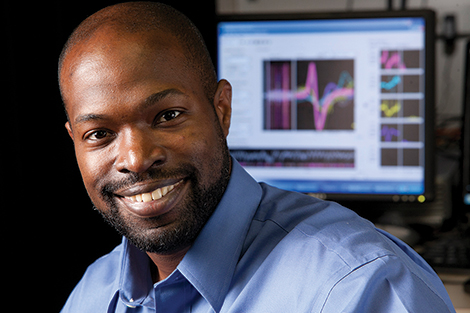Kafui Dzirasa ’01, chemical engineering, is only 38, but is already emerging as a national leader in brain science. His research – which posits that some of the most common mental illnesses might be explained by unexpected connections between electrical patterns in different parts of the brain – could lead to more targeted and effective ways to treat conditions from schizophrenia to autism to depression.
The former Meyerhoff Scholar has also drawn national attention. Last October, as part of a White House panel on research, he found himself explaining to the leader of the free world what it means to think about the brain as an engineered electrical system.
Dzirasa started out at UMBC as a chemistry major but switched to chemical engineering so he could continue using math and computer science, subjects he enjoyed in high school. As graduation approached, he found himself gravitating toward health-related fields, so he stayed on for a fifth year to take pre-med courses and serve as student body president. “I realized it would be useful to learn as much about the body as I could,” he says.
Dzirasa then headed to Duke University to earn his M.D./Ph.D. in bioengineering, with the goal of designing neuroprosthetics—devices that interface with and augment the brain’s abilities and functions. But a stint in Duke’s schizophrenia ward realigned Dzirasa’s plans, awakening him to the huge need for better mental health treatments. “It was not until I got to the clinic that I realized mental illness was a real thing,” he says. “It was tremendous wake-up call.” Instead of giving healthy people additional capabilities, he realized he could help sick people live fuller lives by creating neuroprosthetics for mental illness.
While scientists believe that psychiatric symptoms should map onto underlying physical conditions in the brain, identifying those conditions has been challenging. Scientists still have a limited understanding of the neural basis of most illnesses or why treatments such as antidepressant drugs and electroshock therapy are effective.
Dzirasa, now an assistant professor in Duke’s biomedical engineering and neurobiology departments, hopes to change that by studying the brain’s electrical signals. Though we hear a lot about brain chemicals, the brain is also electrical: Like the information-processing transistors in your computer or phone, each of the roughly 100 billion neurons in your brain transmits information using electrical impulses. Dzirasa takes advantage of this by inducing various conditions—stress, bipolar disorder, even drug addiction—in mice and using tiny implanted electrodes to measure how electrical activity changes.
He uses mathematical and computational tools to find connections between recorded electrical patterns in different brain areas. In the prestigious journal Neuron, he recently reported an instance in which communication between two regions in a mouse’s brain was influenced by activity in a third, seemingly unrelated, one. When he exposed the mice to stress, the communication broke down. “It’s almost like parents sitting in the front seat of a car and kids sitting in the back,” he says. “When the parents are controlling the kids’ communication, everything is fine. But if you tell the kids to stop talking and they don’t, then you’ve got problems. We found that the parent lost the ability to control the kids’ communication.”
Dzirasa’s ultimate goal is to make a “pacemaker” for the human brain. Like the heart implant that restores a regular heartbeat, his dream device would correct faulty electrical signals that underlie debilitating conditions such as schizophrenia and bipolar disorder. “If mental disorders are problems with electricity, we should be able to treat them using electricity,” he says. “I could see a future in which people sleep in a hat” wired with electrodes to stimulate healthy brain function.
A recent discovery may be a step in that direction: Dzirasa and colleagues have figured out a way to not just read but write electrical information from one part of the brain to another. He has a paper coming out and a patent pending on the technique. But challenges remain. For obvious reasons, he cannot stick wires into a living human the way he can in a mouse, and there are significant differences between how mouse and human brains work that need to be accounted for. Translating his findings from mice to humans is “the next step,” he says.
Dzirasa credits UMBC’s Meyerhoff Scholarship program with shaping his career ambitions. And he is now giving back to the program that helped him, returning to campus once or twice a month to mentor scholars in “everything from career advice to life advice, decision-making advice—all the things that go along with helping college students figure out their place in the world.”
It’s yet another set of connections through which Dzirasa is making the world a better, more caring place.
— Gabriel Popkin
Image: Les Todd, Duke Photography
Read more about brain research at UMBC in “Staking Our Claim.”
Tags: brain, Duke, Kafui Dzirasa, meyerhoff, mhoff, Spring 2017

